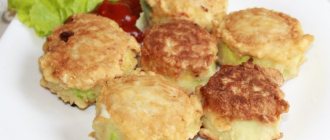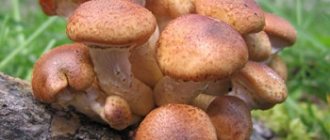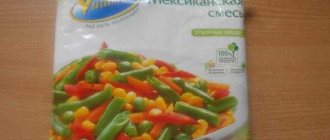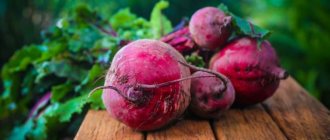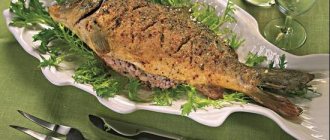Dietary properties of champignons:
Have you, reader, ever tried champignon mushrooms? This variety of mushrooms is very popular in cooking, so many are interested in finding out whether the energy value of this product is high. Many would like to get rid of extra pounds or are afraid to gain them, but many would also not want to completely give up their favorite dish - mushrooms.
Champignons are known to be a delicious product. These mushrooms have excellent taste and amazing aroma, which they do not lose even after high-temperature treatment. They have learned to make a great variety of different dishes from champignons; they are successfully combined with meat, fish, vegetables and other products. They can be eaten fresh, dried, pickled and canned.
Champignon contains 88-92% water, a number of proteins and carbohydrates, organic acids, and mineral components.
Among their vitamin composition, vitamins PP (nicotinic acid), E, D, and B vitamins can be noted. Minerals are represented by iron, phosphorus, potassium, zinc, which, by the way, is important for human immunity. In terms of the amount of phosphorus, champignons can compete with fish products.
With such a rich composition that champignons have, the calorie content of such mushrooms is very small, which allows them to be included in a variety of diets without thus depriving ourselves of the substances we need. The low sodium content makes it possible to use champignon mushrooms in salt-free diets. These mushrooms are also good for those suffering from diabetes - they contain virtually no sugar or fat.
In terms of the amount of B vitamins, champignons are ahead of fresh vegetables. Most of all, they contain riboflavin (B2) and thiamine (B1), which help fight headaches and migraines. Another component - pantothenic acid - will help overcome fatigue. This type of mushroom promotes healthy skin. All this testifies to how useful mushrooms such as champignons can be.
Cooking: cooking champignons
Fresh champignons are an instant product; they taste like nuts. Raw mushrooms are peeled, washed under running cold water, cut into slices and added to other ingredients. Do not soak them, otherwise they will become watery and tasteless. They are used in cold appetizers and salads. Champignons are very popular because they can be used to prepare many delicious dishes.
Wild white champignons are perfect for sauces and soups, giving dishes a pleasant mushroom aroma. But when fried, they become meaty and dry. Artificially bred white champignons are versatile and go well with vegetables and meat. They can be subjected to almost any heat treatment: boiling, frying, baking, steaming, grilling, in the oven, in clay pots. They make amazing mushroom sauces, soufflés, gravies and even pie fillings.
Before cooking, the mushrooms are peeled, washed, placed in boiling water, which is pre-salted, and cooked for 5-7 minutes. Dried champignons are used to make sauces, stews and other dishes. This product can be stored for up to 2 years. Mushrooms are baked at a temperature of 190°C for 15 minutes on a greased baking sheet. To fry them, you will need to cut the champignons in half or pieces, throw them into the frying pan, adding vegetable oil at the rate of 2 tbsp. l. butter per 100 g of mushrooms. Fry them for 3-4 minutes over medium heat until they become darkened and soft.
It is worth noting that mushrooms should not be given to children under 5 years of age during breastfeeding and pregnancy. This product should not be used by people with chronic diseases of the intestines, kidneys, stomach, liver or pancreas. Cancer patients are prohibited from eating champignons.
You can learn about the benefits of champignons for weight loss in the following video:
Champignons are a healthy product that is used for cooking, losing weight, and normalizing the functioning of body systems. Mushrooms contain easily digestible protein and antioxidants that help eliminate free radicals. In order for champignons to bring only benefits, they must be grown, collected and stored correctly.

Champignons are nutritious and healthy mushrooms, which contain a lot of protein and almost as much phosphorus as fish. Athletes often add mushrooms to their diet, since plant protein is absorbed several times faster than animal protein. In addition, champignons are a dietary product suitable for a healthy and proper diet. Women who are trying to lose weight can arrange fasting days on mushrooms, and also use them in various diets instead of meat, which will significantly speed up the process of reducing body fat.
How many calories are in champignons?
For those who love champignons, we have good news. This type of mushroom will not harm your figure - thanks to the low energy value that champignons have.
The calorie content of fresh champignons is low and amounts to:
27 kcal per 100 grams of product
Proteins, fats and carbohydrates (BJU) of fresh champignons in gr. per 100 grams:
Proteins - 4.3
Fats – 1.0
Carbohydrates – 1.0
Which, you see, is quite a bit.
What is the calorie content of champignons prepared in different ways? And here it is:
Calorie table, per 100 g. product:
| Product | Calories, in kcal |
| calorie content of fried champignons | 50,0 |
| calorie content of boiled champignons | 20,5 |
| calorie content of stewed champignons | 53,8 |
| calorie content of baked champignons | 30,0 |
| calorie content of grilled champignons | 36,0 |
And the nutritional value of champignons prepared in different ways is as follows:
Nutritional value table (BZHU), per 100 g. product:
| Champignon | Squirrels, gr. | Fats, gr. | Carbohydrates, gr. |
| fried | 3,6 | 3,1 | 2,8 |
| boiled | 4,65 | 1,0 | 0,1 |
| stewed | 4,0 | 3,2 | 2,0 |
| baked | 4,2 | 1,3 | 0,5 |
| Grilled | 3,2 | 1,0 | 3,2 |
Champignon
Champignon is one of the most common mushrooms in the world. It is used by famous chefs from many countries in their signature dishes.
Can be grown on specially adapted mushroom farms and even at home. The term “champignon” comes from the French champignon, which means “mushroom”.
Popularly known as dung mushroom, pecheritsa, pecherka, cow mushroom.
Champignon belongs to the agaricaceae (lamellar) family, which unites mushrooms of 13 genera of different species. Nowadays there are more than 60 species. The most common of them are field (meadow), ordinary, steppe, double-ring, forest champignon. Two types of mushrooms - yellow-skinned and variegated - are not used in cooking due to their toxicity.
Champignons of many types are widely distributed throughout the world. They grow in the forest-steppe and steppe zones of Europe, the South American pampas, North American prairies, open areas and meadows of Africa and Australia, and the steppes of Central Asia. They can be seen everywhere - on the bark of dead trees, humus, anthills, in forests among the grass, along roadsides, etc.
Champignons have a diameter of 3 to 25 cm. Their cap is often dense, fleshy, spherical in shape, and in maturity it becomes umbrella-shaped.
The surface is fibrous, smooth, scaly, grayish-white in color, and as the fungus grows it may become brownish and brown. The plates are white at first, and then with age they turn slightly pink and darken.
The leg is dense, smooth, and as it ripens, a clearly defined two-layer or single-layer ring is visible.
When collecting champignons, inexperienced mushroom pickers may confuse them with toadstools, because these mushrooms at the initial stage of development are very similar to each other. Champignons differ from the poisonous toadstool by the absence of a tuberous thickening at the base of the stem and by dark or pale pink plates. To play it safe, it is better to collect small champignons that grow separately.
Nutritional value and composition
Champignon is 80% water. Another 20% are vitamins, organic acids and minerals.
Table 1 “Chemical composition of champignons”Composition per 100 gramsVitaminsMinerals
| Squirrels | 4.3 g |
| Carbohydrates | 0.1 g |
| Fats | 1 g |
| Water | 81 g |
| Ash | 1 g |
| Alimentary fiber | 2.6 g |
| Unsaturated fatty acids | 0.1 g |
| Saturated fatty acids | 0.1 g |
| Mono- and disaccharides | 0.1 g |
| Vitamin A | 2 mcg |
| Beta carotene | 0.01 mg |
| Thiamine (vitamin B1) | 0.1 mg |
| Riboflavin (vitamin B2) | 0.45 mg |
| Pyridoxine (vitamin B6) | 0.05 mg |
| Pantothenic acid (vitamin B5) | 2.1 mg |
| Folic acid (vitamin B9) | 30 mcg |
| Vitamin PP | 5.6 mg |
| Vitamin E | 0.1 mg |
| Vitamin C | 7 mg |
| Calcium | 4 mg |
| Potassium | 530 mg |
| Sodium | 6 mg |
| Phosphorus | 115 mg |
| Sodium | 6 mg |
| Chlorine | 25 mg |
| Fluorine | 14 mcg |
| Iron | 0.3 mg |
| Iodine | 18 mcg |
| Zinc | 0.28 mg |
| Chromium | 13 mcg |
| Cobalt | 15 mcg |
| Molybdenum | 3 mcg |
| Rubidium | 26 mcg |
As you know, all mushrooms are rich in proteins. And champignons are no exception: 1 kilogram of this product contains approximately as much protein as 1 liter of cow's milk. Pecheritsa protein contains 18 amino acids, 8 of which are essential (they enter the human body exclusively with food and cannot be synthesized).
Japanese researchers have found that champignons contain high amounts of amino acids such as lysine and arginine, which have a beneficial effect on the development of human mental abilities and memory. The protein of this mushroom is absorbed by 70-80%. Therefore, those who consume them can, without harming their health, give up sausages and meat.
Champignons are similar in phosphorus content to fish. Their chemical composition is quite large, and this distinguishes these mushrooms from others. They harmoniously combine vitamins, beneficial macro- and microelements. The caloric content is very low - 100 grams contain no more than 27 kcal.
A little history
The champignon is one of the first cultivated mushrooms. We owe its wide distribution primarily to the King of France, Louis XIV (1638-1715).
He was a connoisseur of mushroom dishes and ordered his gardeners to “domesticate” meadow champignons.
At first they were grown on lawns as seed, using mycelium that was collected in nature, and then collected from their beds.
At the end of the 17th century, it was noticed that pecheritsa could grow well in underground rooms and basements. Their cultivation in France reached its maximum development in the 18th-19th centuries, especially near Paris.
This was facilitated by the presence of old quarries, in which throughout the year the temperature was in the range of 12-14 ° C, favorable for the cultivation of these mushrooms.
Champignon culture from France penetrated into Germany, Great Britain and other European countries. Since 1903, they began to be grown in America.
In 1893-1894 in France, the Pasteur Institute developed a method for germinating champignon spores and obtaining sterile mycelium. In most countries where the culture of these mushrooms had already spread, by 1924 special laboratories had been developed where their sterile mycelium was produced. In Russia, champignons began to be bred starting in the middle of the 18th century.
Today, champignons are cultivated in more than 70 countries around the world. This industry is most developed in the UK, USA, Germany, France, Denmark, the Netherlands and other countries. About 25% of production occurs in the United States, which is also the main exporter of such mushrooms.
The largest plantation in the world is located in an old limestone mine in Pennsylvania. The underground galleries of the plantation are 24 kilometers long.
Cultivation of champignons
The reason for the widespread production of champignons is their abundant fruiting, excellent taste and unpretentiousness. In terms of their nutritional properties, cultivated pecheritsa are similar to wild ones, but their value is much higher. They can be grown all year round. Champignons bear fruit well in the dark due to the lack of chlorophyll in their tissues.
Nowadays, the production technologies of these mushrooms have almost reached absolute automation. They are grown in specially equipped basements, greenhouses, and open ground. Champignons grown artificially are not capable of polluting the external environment.
Modern technologies make it possible to prevent the penetration of toxic substances, bacteria, and protein breakdown products into the mycelium.
Purchase and selection
Fresh champignons can be purchased in stores and markets. When choosing, you need to pay attention to the following criteria:
- fresh mushrooms are white, sometimes with a pinkish or beige tint;
- matte surface of the cap;
- absence of dents, dark areas or stains on the surface;
- the damaged integrity of the film connecting the stem and cap indicates the “old age” of the mushroom;
- smell the mushroom - its freshness is indicated by a pronounced pleasant smell that resembles anise;
- fresh champignon is elastic to the touch, but spoiled one is like a sponge.
Storage conditions
Let's consider different options for storing champignons.
- Opened mushrooms can be stored in the refrigerator for up to 2-3 days - not covered with film, they become airy and begin to darken. Under cling film, the shelf life is extended to 5-6 days. If stored for a longer period of time, they can harm the body.
- To increase shelf life, champignons are frozen. In this form they can be stored for a very long time, but defrost them in portions - they should not be allowed to re-freeze. To freeze fresh mushrooms, you need to wash them well, dry them, and if necessary, cut large ones into pieces and trim off the excess. After this, freezing is carried out. Store them in tightly tied bags.
- You can freeze pre-fried champignons. To do this, add oil to a deep frying pan and fry until the moisture evaporates or put it in the oven without oil. Then the fried mushrooms are placed in a container and frozen. They can be stored in this form for no more than 6 months.
- The champignons are washed and boiled in lightly salted water, cooled, dried thoroughly, placed on foil or a baking sheet in one layer and frozen. Shelf life - no more than six months in tied portion bags.
Use in cooking
Champignons are widely used for preparing a variety of dishes, pickled, dried, frozen or fried.
They are baked in clay pots, added to salads, soups, snacks, baked goods (as a filling for pizzas, sandwiches, zraz, pies), stewed in sour cream or various sauces.
Young mushrooms are often eaten because they have the most delicate taste. In cooking, more than 200 dishes can be prepared from them.
Champignons go well with vegetables, seafood and fish, meat, cereals, eggs, and cheese. Many people like stewed potatoes with champignons, but, according to nutritionists, mushrooms and potatoes do not go well together, just like with nuts and milk: dissimilar proteins, high glycemic index of starch - as a result, digestive upset is possible.
Before cooking, the mushroom must be cleaned of soil and other contaminants. First, use a knife to clean off the dirt and quickly rinse the champignons under running water. It is not recommended to leave them in water for a long time, otherwise the mushrooms will become tasteless and watery. When cleaning, the film that is located between the cap and the stem is removed. The bottom of the leg is cut off if it is dirty.
Although champignons can be eaten fresh, in most cases they are eaten after short-term heat treatment. Champignons that are grown industrially are more widely used because they tolerate any type of cooking well. Wild ones are well suited for fillings, sauces, and first courses. But they are not suitable for frying - they will become very hard and dry.
Medicinal properties
Champignons have medicinal properties. They have found their application in folk medicine and dietetics.
- The low calorie content of champignons allows them to be used in various diets for weight loss, without depriving yourself of essential vitamins and other beneficial substances. Due to its low sodium content, it is successfully used in salt-free diets.
- Such mushrooms can be eaten by diabetics - they contain no sugar and virtually no fat.
- Champignons have the ability to cleanse the body by removing heavy metal salts.
- They contain aromatic and flavoring extractive substances, which in the body cause the release of digestive juices in abundant quantities, improve the absorption of food and stimulate appetite, and enhance metabolism.
- Due to its expectorant and bronchodilator effect, it can be used for the complex treatment of bronchopulmonary pathology (bronchial asthma, bronchitis, etc.).
- Can lower cholesterol levels and prevent the formation of plaques. Studies have shown that people who often consume these mushrooms have 34% lower blood cholesterol levels compared to those who do not eat champignons. Therefore, the risk of heart attack and atherosclerosis is reduced.
- Due to the high content of riboflavin and thiamine, the use of pecheritsa helps prevent headaches and migraines.
- Helps get rid of psoriasis, eczema, ulcers, purulent skin lesions.
- Slows down skin aging - can be used to make masks.
- The healing properties are also preserved in dried mushrooms. They should be consumed by those people who suffer from stomach ulcers and hepatitis.
Contraindications
Despite the usefulness of champignons, there are contraindications to their use:
- It is not recommended for consumption by patients with chronic kidney and digestive diseases.
- The high content of folic acid in mushrooms promotes the growth of malignant cells and their reproduction, so cancer patients should not eat champignons.
- You need to be careful with such mushrooms when breastfeeding and pregnancy.
- Children under 5 years old should not eat any dishes with champignons, even if it is only, for example, a topping on pizza or pies, since their bodies do not have enough enzymes necessary for their digestion.
Champignon is an amazing mushroom that is rich in vitamins and minerals. It is not only an excellent nutritious product, but also has many beneficial properties, thanks to which it is widely used in cosmetology, dietetics and folk medicine.
Source: https://FoodandHealth.ru/griby/shampinon/
Recipe? Recipe!
How to prepare this dish at home? Quite simple. Here is one of the recipes:
Fried champignons:
- Champignons – 8 pieces
- Butter - 1 tablespoon
- Cream - 2 tablespoons
- Lemon juice – 1 tablespoon
- Salt - to taste
- Black pepper (ground) – ¼ teaspoon
- Parsley or dill (greens) - to taste
The champignons are pre-washed, the stems are cut off, and the films are removed from the caps. Large caps can be cut into pieces of the required size. Mushrooms are fried in oil over high heat, seasoned with salt and pepper, and adding finely chopped herbs.
When the caps are soft, add cream (or sour cream). Everything needs to be boiled, sprinkled with lemon juice. The finished dish can be served with boiled or fried potatoes, or with rice.
How are these mushrooms useful? Great video!
The benefits and harms of champignons: what, for, health, body, person
Vladimir Kuzmich January 17, 2020
Hello, my dear readers! Tell me, how do you feel about mushrooms? They have long settled on our table, and mushroom picking is even called “silent hunting.” But today we are not talking about forest mushrooms, but about those that have become more popular today than boletus and aspen mushrooms. I'm talking about champignons. The topic of today's conversation is the benefits and harms of champignons.
Most recipes with mushrooms, whether in a book or a culinary website, mention them. But what is so special about these mushrooms? Champignons do not smell like forest. It is not for their sake that mushroom pickers are trying.
Except they look beautiful - small white mushrooms, clean and smooth. And what else? Are champignons good for health? How and how much can you eat? What benefits do they bring to the body and do they bring them at all? Let's figure it out together.
What do we know about champignons?
According to some data, champignons first appeared in France in the middle of the 17th century. The name of the mushroom itself is of French origin. However, Italy also disputes the right to be called the birthplace of champignons. According to those who adhere to this version, champignons have been known there for about a thousand years.
Or they were even used in cooking back in ancient times.
One way or another, champignons were grown in France in the middle of the 17th century and were quite famous. They grew on compost left over from growing other crops. They penetrated the territory of the Russian Empire, according to some sources, already in the middle of the 18th century, and according to others, only in the 19th century.
And, like any curiosity, at first they were available only to wealthy segments of the population. Gardener E.A. started growing mushrooms on an industrial scale. Grachov in 1848. In 1860-1861 he published articles on this topic. Over more than three centuries of champignon cultivation, they have come a long way, but have become almost the most popular mushrooms in cooking.
Composition of champignons
Like any other mushrooms, champignons are a source of vegetable protein and a fairly filling product.
They contain no less phosphorus than fish, and no less potassium than vegetables and fruits. They also contain a lot of vitamin B. 100 g of champignons contain only 27 kcal, which makes them acceptable for dietary nutrition. The same amount of mushrooms contains:
- proteins – 4.3 g;
- fats – 1 g;
- carbohydrates – 0.1 g.
The majority of water in mushrooms is 91 g per 100 g. Everything else is dietary fiber and ash. Let's see why they are useful.
Vitamins and minerals
So, champignons are a rich source of B vitamins.
The total amount of vitamin B in mushrooms exceeds all others, although they are also present there.
They are also rich in microelements necessary for the body. In descending order, the table of elements looks like this:
- potassium – 530 mg;
- phosphorus – 115 mg;
- sulfur – 25 mg;
- chlorine – 25 mg;
- magnesium – 15 mg;
- sodium – 6 mg;
- calcium – 4 mg;
- silicon – 3 mg;
- iron – 0.3 mg;
- zinc – 0.28 mg;
- manganese – 0.128 mg;
- copper – 500 mcg;
- aluminum – 418.9 mcg;
- titanium – 57.5 mcg;
- rubidium – 26 mcg;
- selenium – 26 mcg;
- iodine – 18 mcg;
- strontium – 16.8 mcg;
- cobalt – 15 mcg;
- fluorine – 14 mcg;
- chromium – 13 mcg;
- molybdenum – 3 mcg;
- vanadium – 2 mcg;
- lithium – 0.8 mcg.
Thus, champignons contain the most potassium and phosphorus. Potassium is essential for the soft tissues of the body. And phosphorus is responsible for the normal functioning of almost all body processes.
Fish is usually considered a rich source of phosphorus. But if someone doesn’t like it or because of an allergy, it can be replaced with champignons. And then this element will enter the body in the required quantity.
Incredibly, champignons compete with fish in terms of phosphorus content!
The benefits of champignons for humans
These “homemade” mushrooms bring many significant benefits to people.
Firstly, they are a source of vegetable protein, so they can serve as a vegetable substitute for meat.
Secondly, they can be included in your diet because they are low in calories but very nutritious.
Thirdly, they fill you up, and therefore there is no desire to snack between meals.
Fourthly, champignons are useful for atherosclerosis. As a plant product, they do not contain cholesterol. In addition, they help remove excess fluid from the body. They also remove toxins.
Finally, large amounts of B vitamins help strengthen the nervous system. Thus, champignons are good in the fight against neuroses and depression.
The benefits of champignons for women's health
I already mentioned that champignons are low in calories. Champignons have very little fat. Therefore, according to nutritionists, they are good for weight loss. But, besides the fact that they can be included in the diet, they bring many benefits to the female body. Taking into account features that are characteristic only of women.
Champignons are an excellent antioxidant. They help slow down tissue aging and have a beneficial effect on the condition of the skin and hair.
But this is not the limit. They are good to eat to prevent cancer. Regular consumption of champignons reduces the risk of breast cancer.
According to one indicator, champignons are very useful for pregnant women. The protein in their composition is necessary for the growth and development of the child. But you need to eat them carefully. Some doctors do not recommend eating champignons at all during pregnancy.
Because they can cause flatulence and other intestinal problems.
When breastfeeding, they can also be included in the menu. But it's better boiled or stewed. Frying can have a negative effect.
The benefits of champignons for men's health
Protein, which I talk about so often, helps build muscle mass.
Therefore, champignons can be included in the diet of men who play sports. Low fat and carbohydrate content helps keep you in shape.
A large amount of potassium reduces the likelihood of cardiovascular diseases. Champignons are good for diabetics because they contain virtually no sugar. They help lower blood sugar levels and maintain normal levels.
For example, studies were conducted on laboratory animals in the UK, University of Surrey. During which it was found that champignons reduce the need for insulin in diabetics and improve their well-being.
They do not contain cholesterol, so champignons are a good prevention of atherosclerosis of the body's blood vessels.
Selenium is beneficial for the reproductive system. In addition, champignons contain enzymes that maintain high levels of testosterone in the body of men.
They are useful for hypertension because they help normalize blood pressure.
This is an important property because a large number of mature men suffer from high blood pressure. Regular consumption of these mushrooms will help avoid the unpleasant consequences of this disease.
Champignon salad recipe
According to established tradition, I am sharing with you a recipe for a delicious salad with champignons. There are few ingredients in it, but they all combine correctly. To prepare you will need:
- eggplant – 2 medium-sized pieces;
- champignons – 250 g;
- tomatoes – 2 medium-sized pieces;
- onion – 1 piece;
- parsley;
- salt – 1 tbsp;
- vegetable oil;
- sour cream – 130 g;
- walnuts - a handful;
- garlic – 1 clove;
- lemon juice – 1 tbsp;
- salt;
- pepper.
Eggplants need to be cut into slices and sprinkled with salt. This way they will give juice. And cut the champignons into slices. Chop the onion into small cubes and fry until transparent in one tablespoon of oil. When it is ready, you need to add the champignons.
Then mix everything together and fry over medium heat until the mushrooms are browned. Then you need to tackle the eggplants. The salt did its job. Now it's time to rinse the eggplants and pat them dry with a paper towel. And then fry on both sides until golden brown.
After frying, excess oil must be removed. Paper towels are also suitable for this. But you can cook the same dish in your own juice. As shown in the video.
Now you can start assembling the salad. Cut the tomatoes into slices too and begin assembling layer by layer. The first layer is eggplant, then tomatoes. Note that the tomatoes did not undergo any pre-treatment other than washing.
The salad needs a dressing. Use the remaining ingredients for this. Mix sour cream, chopped garlic, chopped nuts, lemon juice, salt and pepper. Stir well and place a third layer on top of the salad. Then place the last layer of mushrooms and decorate with herbs. Delicious salad is ready!
How to simply and usefully cook champignons on video:
Poor quality mushrooms can cause serious harm to health. Therefore, you need to know how to choose good ones. A quality mushroom is usually white, although it may be slightly brownish. The darker it is, the more mature it is. It is better not to take ones that are too dark - they are most likely overripe.
They will not cause harm, but will become tough during cooking. Hats must be clean and free of stains. The mushroom itself should feel dense, elastic, and without damage. The smell should be pleasant.
And most importantly, if the mushroom is wet and sticky, it is spoiled!
Keep in mind - the higher the storage temperature, the faster they deteriorate.
Watch the benefits and harms of champignons on video:
However, champignons can be not only beneficial, but also harmful to the body. Like any other product, it has contraindications, depending on individual characteristics. Here is a list of conditions under which mushrooms should not be eaten:
- diseases of the gastrointestinal tract;
- individual intolerance;
- age up to 5 years;
- age after 60 years;
- liver diseases;
- kidney diseases;
- gout
- use of low-quality (spoiled) mushrooms.
In addition, mushrooms in general and champignons, including, contain a lot of indigestible fiber.
Therefore, in diseases of the gastrointestinal tract, mushrooms act as a very heavy food. The digestion process can cause discomfort and worsen health problems.
That's all for me! I hope that you understand the benefits and harms of champignons. Perhaps you have discovered some new and hitherto unknown properties that are useful to you. If so, then I'm glad. I also hope that you will continue to find something interesting for yourself. Share the post on social networks, show it to your friends and come back again! You will be welcome. See you again!
Source: https://familystr.com/zdorove/pitanie/polza-i-vred-shampinonov/
What are the benefits of champignons for weight loss?
Can champignons be used to lose extra pounds? Can! After all, the low calorie content of mushrooms allows them to be used as a dietary product without giving up essential proteins, vitamins and microelements. In addition, mushrooms quickly cause a feeling of fullness, which leads to a decrease in the amount of food eaten per day.
A study was conducted on volunteers in Britain. They replaced meat dishes with mushroom dishes 4 times a week. Those who participated in the experiment quickly began to lose weight and lost from 5 to 9 kg over 5 weeks of observation.
Besides:
Eating champignons will not affect your figure in any way, since they are ninety percent water and have a very low calorie content (only 27 kcal per 100 g).
Champignons contain a minimal amount of fat and at the same time satisfy hunger quite effectively.
They contain a high percentage of protein, which is great for losing fat mass and strengthening muscle mass.
If you consume one hundred and fifty grams of champignons once a day for a month instead of the main meal, then during this period you can lose a couple of kilograms without straining. And if you regularly eat mushrooms after losing weight, then the previous weight, as a rule, does not return.
Mushrooms contain a large amount of plant fiber. They help improve metabolism and gain a feeling of fullness.
When losing weight, mushrooms provide the body with a sufficient amount of energy, as they contain a lot of protein, vitamins and microelements. During the diet, the body will not experience a deficiency in nutrients.
Champignons do not provoke fat deposition.
There is a diet that some American celebrities have used and quite successfully. The essence of the diet is that you need to replace one of the daily meals - lunch or dinner - exclusively with mushrooms (200 g of them are needed). The duration of this diet is fourteen days. This will allow you to lose about four kilograms over this period of time.
Contraindications:
Mushrooms should not be overused, especially for people with diseases such as pancreatitis, peptic ulcers, low stomach acidity, liver problems, and gout. Because all of this is junk food. And children under the age of twelve are not recommended to give mushrooms at all. By replacing a hearty lunch or dinner with a dietary dish of champignons, you can deliciously satisfy your hunger without getting a large number of calories in return.
Fresh champignons
Champignons are mushrooms of the Lamellar
, the most common representatives of the mushroom fraternity. Champignons have the most traditional mushroom appearance - a fleshy round cap on a thick, medium-length stalk. As the mushrooms grow, the cap gradually opens like an umbrella, the diameter changes from 2.5 to 20 cm, white plates become visible under it, which over time turn pink or turn brown (calorizator). Champignons can be white, cream or light brown in color; mushrooms have a bright mushroom aroma and a fairly neutral taste.
Fresh champignons are specially grown in greenhouses, cellars and open ground. The French were the first to begin cultivating forest champignons, even the word mushroom
in French it
sounds like champignon . The first myceliums were taken from wild mushrooms, then, after the invention of a method for germinating spores, the cultivation of champignons became practically universal.
Calorie content of fresh champignons
The calorie content of fresh champignons is 27 kcal per 100 grams of product.
Composition and beneficial properties of champignons
Fresh champignons contain vitamins B, D, E, PP, as well as some minerals, such as: potassium, calcium, zinc, selenium, copper and manganese, iron, phosphorus, almost two dozen amino acids, many of which are essential, which enter the body only with food, without being synthesized internally. High-quality, easily digestible protein, which champignons are rich in, is an alternative to meat protein, which is necessary for the construction of body cells. Specially grown champignons are environmentally friendly, their contact with environmental pollution is minimal. It is useful to consume fresh champignons to normalize the activity of the cardiovascular system, reduce the level of “bad” cholesterol in the blood, and to remove heavy metal salts. Champignons contain antioxidant substances that fight free radicals.
Harm of fresh champignons
Champignons contain fungin, a difficult-to-digest substance that can cause stomach discomfort. Champignon dishes are not recommended for children, especially under five years of age.
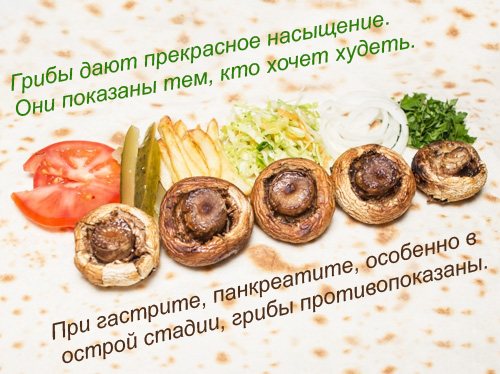
Champignons for weight loss
Fresh champignons often replace meat in various diets and fasting days; they are used by athletes during heavy loads to build muscle mass. An example of using champignons is a nourishing diet.
Selection and storage of champignons
When choosing fresh champignons, you need to pay attention to the appearance of the mushrooms - elastic flesh, stretched skin on the cap, absence of damage, dark spots and signs of dryness become fundamental signs of the freshness of the product. If fresh mushrooms are packaged in cling film on which drops of water are visible, it is better to refrain from purchasing them.
Fresh champignons should be stored in the refrigerator, in a paper bag or plastic container without a lid. Mushrooms retain their beneficial properties for 5-7 days.
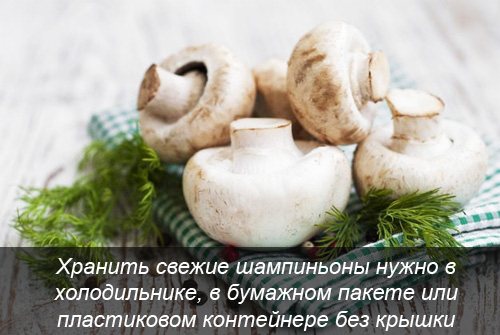
Growing and varieties of fresh champignons
Fresh champignons can be grown in a summer cottage or even in a city apartment; the mushrooms are very unpretentious and produce abundant harvests. Growing champignons does not require special conditions, they do not need sunlight, mushrooms grow well in cellars and basements on well-moistened soils with the addition of manure. Champignons are divided into three large types - forest, meadow and field, within which there are subspecies and varieties. The most expensive and exquisite are royal champignons, large brown mushrooms with the strongest mushroom taste and aroma. Common varieties of champignons that are adapted for cultivation in the middle zone are Somicel, Hauser A15, Silvan 130 and others.
Champignons in cooking
Fresh champignons are a quick-cooking product; long-term heat treatment is not required; champignons are often used raw. To do this, young mushrooms should be thoroughly cleaned and quickly rinsed under cold water, cut into thin slices and mixed with the rest of the ingredients. Raw mushrooms are used in salads and cold appetizers. Champignons are boiled, fried, stewed, baked, grilled. Soups, juliennes, vegetable stews, omelettes, fillings for pies and pancakes, mushroom pates, stuffed caps, pasta sauces, mushroom pizzas, traditional mushrooms fried with onions and potatoes - the list of champignon dishes is endless.
For more information about the beneficial properties of champignons, watch the video clip of the TV show “About the Most Important Thing.”
